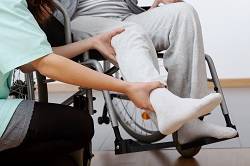 On October 4, 1996, Edith Schaffer suffered a seizure after admitting herself to a psychiatric hospital (Stony Lodge Hospital) in Ossining, NY. After the seizure occurred, she was transferred to a local hospital, and her seizures continued for the next two days. Ms. Schaffer lapsed into a coma, which she remained in for over four years until her death on June 6, 2001. It was determined that her coma was caused by the failure of the physician at the local hospital to diagnose hyponatremia (critically low sodium levels).
On October 4, 1996, Edith Schaffer suffered a seizure after admitting herself to a psychiatric hospital (Stony Lodge Hospital) in Ossining, NY. After the seizure occurred, she was transferred to a local hospital, and her seizures continued for the next two days. Ms. Schaffer lapsed into a coma, which she remained in for over four years until her death on June 6, 2001. It was determined that her coma was caused by the failure of the physician at the local hospital to diagnose hyponatremia (critically low sodium levels).
A Westchester county jury found the doctor who treated her at the community hospital, Binda Batheja, fully liable for not appreciating the significance of Mrs. Schaffer’s condition. The condition is easily treatable and reversible. The jury awarded $5 million for Mrs. Schaffer’s pain and suffering and $3 million for her husband’s loss of services.
The defense appealed the decision (Schaffer v. Batheja), claiming that it was excessive. The Defendant requested that the appellate court either completely set aside the verdict or at least drastically reduced the sums awarded.
Damages for Pain & Suffering
In order to be awarded damages for pain and suffering, the injured person must demonstrate some level of awareness of his / her condition and pain level. Claims based upon conjecture, surmise or speculation regarding the person’s ability to appreciate pain will be dismissed by the Court. This standard was set forth by the New York Court of Appeals in McDougald v. Garber (1989).
In Schaffer, the plaintiff attorneys argued that Mrs. Schaffer definitely had some level of awareness of her pain and suffering. The attorney presented medical testimony that Mrs. Schaffers movements in response to outside stimuli demonstrated some level of awareness of her condition.
The defense for Batheja (who died before Mrs. Schaffer and was never disposed in the lawsuit), argued that there was not enough proof that Mrs. Schaffer had any level of awareness. They contended that Mrs. Schaffer’s movements were purely reflexive. In addition, the medical records showed that Mrs. Schaffer was comatose at all times with no ability to communicate or consciously express her pain.
The jury did not believe the defendant’s arguments and awarded Mrs. Schaffer’s estate $5 million dollars for the almost five years of her pain and suffering. The Appellate Division reduced the jury’s award to $2.5 million. Despite the reduction in the jury’s award, the Appellate Division determined that the medical proof submitted in support of Mrs. Schaffer’s claim was sufficient to prove that she was, at times, able to appreciate her pain.
This decision remains a small victory for the many individuals who remain or have been in an vegetative state or coma to seek recovery for their years of suffering. It is important for any person or family member who is interested in pursuing such a claim on behalf of the injured party to document instances of awareness, such as eye movements, crying or tearing, grabbing of hands or other purposeful movements.
Read more about the Schaffer v. Batheja case and outcome on the New York Case Injury Blog website.

























